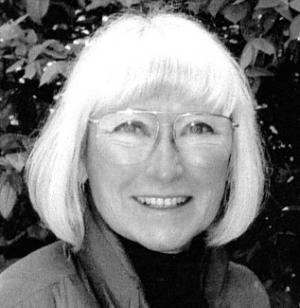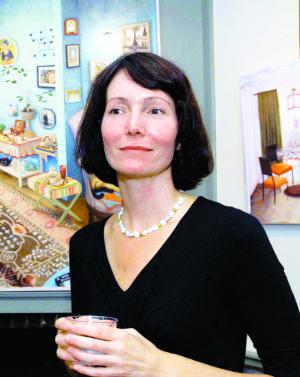Costigan and Taggart works: pathways to other worlds
Other languages have words for certain feelings or concepts that our own English language hasn’t yet distilled into a single word. Schadenfreude, the title of an exhibit of new artworks by Cassie Taggart at Rehoboth Art League, is one of those words. It means taking joy in the misfortune of others.
Also on display, in a side room of the league’s main Corkran and Tubbs galleries, is a collection of new works by Connie Costigan. Between the two, geographically and metaphorically, is a fine exhibit of primarily representational works by members of the league.
To the casual but interested viewer, Costigan’s and Taggart’s work could hardly be more diametrically juxtaposed. Taggart’s works, especially the less recent ones, display a mind in motion: a carousel, electric and whirling, firing in all different directions, barely contained by her own consciousness or the architecture of the rooms that she fills with humans almost catatonic with the overstimulation of our media-hyped worlds.
The Homestead serves as a complementary venue for Taggart’s works because so many of them depict, in Taggart’s unique fashion, life in a home setting. If you can imagine all of the thoughts and dreams, humor and anger, of Whistler’s Mother painted into the room occupied by that famous seated figure – but in a more colorful and Felliniesque fashion – you’ll be on your way to approaching Taggart’s work.
In a large painting over a fireplace, an Alice-in-Wonderland-like girl stands surrounded by books and furniture and animals in an often-incongruent manner. It’s classic Taggart, pushed hard. These highly detailed works invite study, without tests or homework. Just look inside the artist and see her thoughts. A book on a table is titled Love Constipation.
“A lot of these works were done when I was living in Los Angeles,” said Taggart during an opening reception. “There was lots of stimulation out there. I’ve since moved and I’m in a quieter and less hectic place. My more recent works, I think, show a greater appreciation for peace and solitude.”
Maybe it’s not just coincidence that the show’s title, Schadenfreude, includes the name of one of the world’s most celebrated psychologists. Taggart’s work invites you to stay for a cup of tea or coffee and conversation – conversation that could go deep – and is the most overtly psychological work I’ve ever seen. For people who know her work, that observation is about as profound as saying that on clear days the sky is primarily blue. While walking around the exhibit, I heard a snippet of one viewer’s comments: “Even her light fixtures – they’re so organic and creepy!” Another, in a different room, hummed a few bars from the familiar theme music to the television series “Twilight Zone.”
Because she has opened herself so unabashedly, Taggart opens the door for us to look deeper in ourselves. For a journalist and publisher, viewing a show indicting sensationalist media serves as a reminder to take our delvings deeper and to never lose a sense of compassion.
Down the hill from the Taggart exhibit, Connie Costigan’s collection, titled The Presence of the Unseen, focuses on a less worldly world, a world not worldly at all. As opposed to Taggart’s work, you will see no familiar objects, or figures, in Costigan’s work. There is no small irony in what the artist said when I suggested a photograph. “Photographs can’t capture what these paintings are about and how they work.”
Costigan’s works are meditations. They are of the subtle world. In a number of Taggart’s paintings, there are windows and they show the simpler outdoors world of nature beyond the frenetic world in her rooms. In those window scenes are the peace and solitude Taggart mentioned as part of her most recent works, her own form of meditation in the midst of life’s swirl.
Costigan’s works, which she often calls Innerscapes, leave the swirl behind.
They are as overtly meditational as Taggart’s works are psychological. How do you depict a settled mind, one that can reflect the calm of the universe? Costigan’s works don’t attempt to do that; rather, each brushstroke is part of her meditation. Each of her works includes thousands of brushstrokes, a handful of colors, and just a few forms. “And they are everchanging,” said Costigan at the reception. “They change throughout the day, as the light of the day changes.” I imagine Costigan’s mind settling as she applies each stroke of color; she doesn’t know where each meditation will take her but there is a great similarity among her works, just as there are universal truths that show up in all the great religions. Costigan’s Innerscapes offer a chance to see where her meditations take her and feel the presence of the unseen.
But these are just descriptions and words. An old Taoist saying tells us that words are like the finger pointing at the moon. If you want to see the moon, look at the moon, not the finger. The Costigan and Taggart exhibits are unique and provocative and well worth visiting more than once. You can sample the works and read more about them in their bizBriefs section at capegazette.com. Better yet, go see them. They will be on exhibit through October.
















































